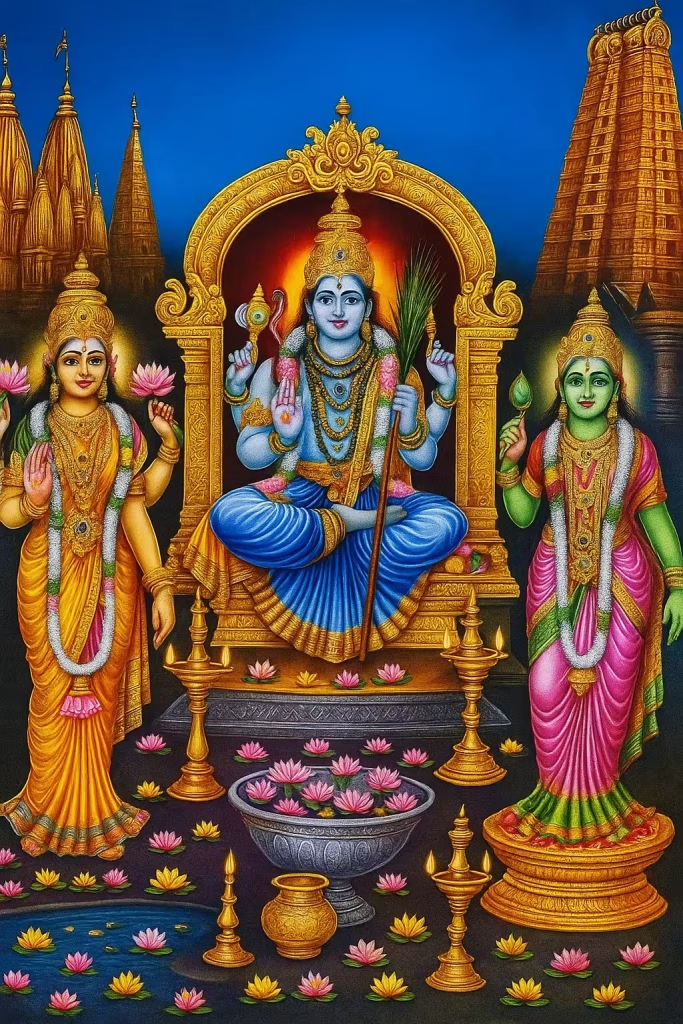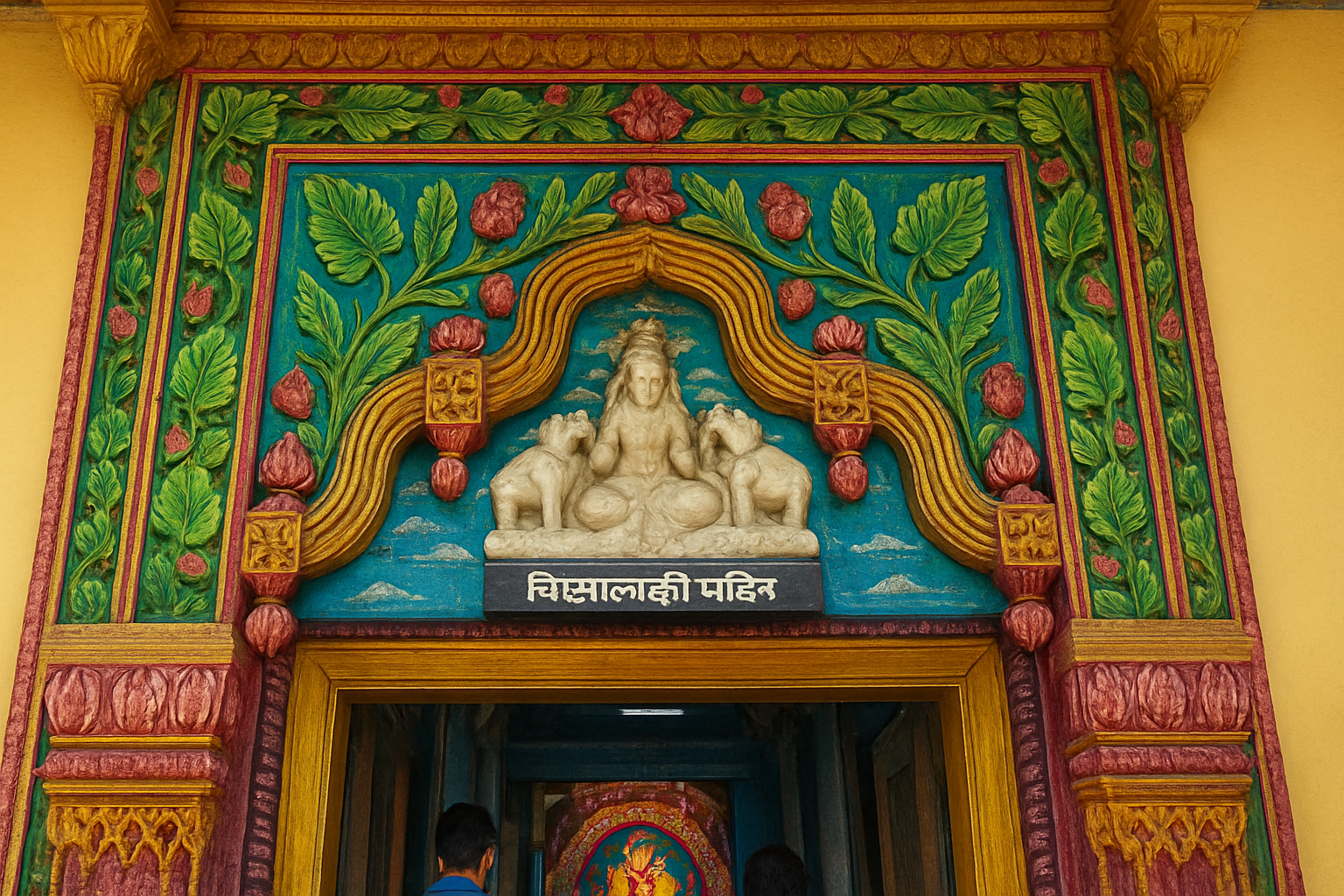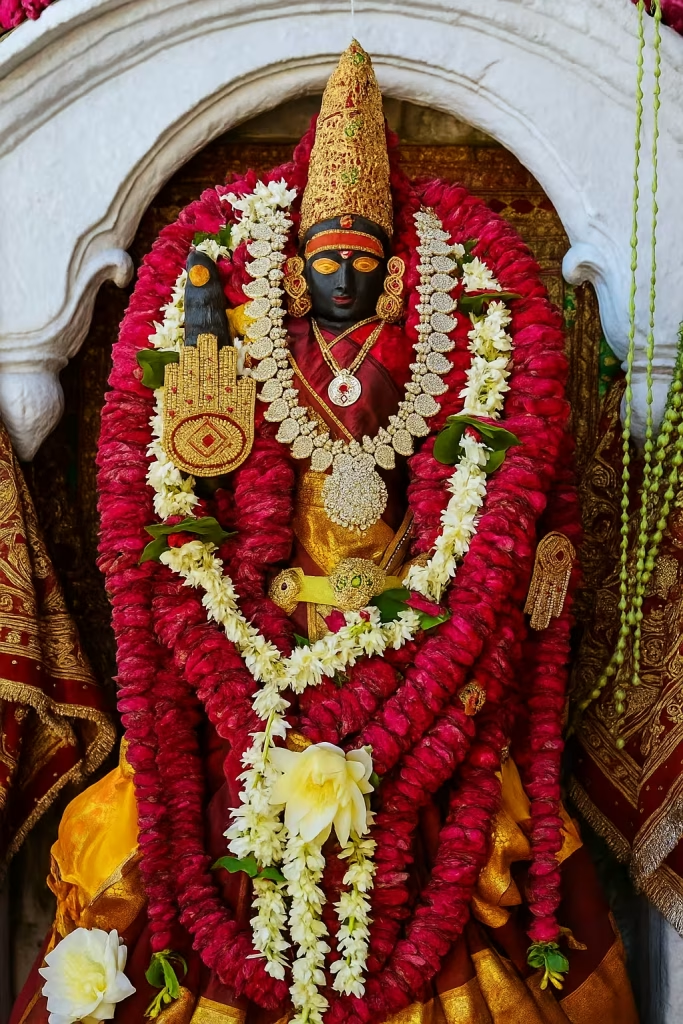Kashi oldest & spritual city of India, Kashi (Varanasi) is a city where believe of every Hindu breathes through every ghat and temple. Among its numerous sacred sites, the Vishalakshi Temple in Banaras holds a special place for devotees of the Divine Mother. Revered as one of the 51 Shakti Peethas, this temple is dedicated to Goddess Vishalakshi, the wide-eyed manifestation of Shakti, symbolizing compassion, wisdom, and protection. Pilgrims from all over India and the world visit this divine shrine to seek blessings, peace, and spiritual liberation.
The Sacred Significance of Vishalakshi Temple
The Vishalakshi Temple in Banaras is not just a temple—it is a gateway to divine feminine power. The name “Vishalakshi” means “one with wide eyes,” symbolizing the all-seeing, nurturing aspect of the Goddess. According to Hindu mythology, this temple is among the sacred Shakti Peethas, formed at sites where parts of Goddess Sati’s body fell when Lord Shiva carried her corpse across the universe in grief.
In this temple, it is believed that the earrings (kundal) or face (mukha) of Goddess Sati fell, sanctifying the land with divine energy. As a result, Kashi became a powerful center of Shakti worship. The temple is also spiritually aligned with the famous Meenakshi Temple in Madurai and Kamakshi Temple in Kanchipuram, forming a trinity of the Devi’s major forms.
Historical Background
While the Vishalakshi Temple in Banaras is deeply rooted in mythology, historical records suggest that it has been a center of worship for centuries. The temple is said to have undergone several reconstructions over time, especially during the invasions and upheavals in medieval India. Some legends associate its current structure with the Maratha rulers, who contributed significantly to temple building in Kashi.
Despite changes and restoration efforts, the temple retains its ancient charm, with intricate carvings, symbolic architecture, and a spiritual aura that transcends time. It stands today not only as a symbol of devotion but also as a testament to the resilience of sacred traditions.
Location and Architecture
This Shakti Peeth Situated in Meer Ghat area of Varanasi. it is a blend of spiritual charm and architectural beauty. The temple is relatively small compared to other grand shrines, yet its atmosphere radiates intense peace and devotion.
The inner sanctum houses the idol of Goddess Vishalakshi, adorned with bright sarees, gold ornaments, and flowers. The large, captivating eyes of the idol are the highlight, drawing devotees into a sense of divine connection.
Rituals and Festivals at Varanasi Shakti Peeth
The temple comes alive during major Hindu festivals, particularly:
Navratri: A nine-day celebration of the divine feminine, with daily special pujas, bhajans, and aarti.
Shravan Month: Special prayers to Lord Shiva and Goddess Vishalakshi.
Kajali Teej: Unique to Varanasi, celebrating the bond between husband and wife under Goddess Vishalakshi’s blessings.
Mangala Aarti, Bhog Aarti, and evening Sandhya Aarti daily done by the priest of the Temple. Devotees often offer sarees, bangles, kumkum, and sweets as part of their worship.
Vishalakshi and the Shakti Peetha Network
The Vishalakshi Temple in Banaras is often counted among the 51 or 108 Shakti Peethas, depending on different traditions. These Peethas are sacred sites spread across the Indian subcontinent, where parts of Sati’s body or her ornaments are believed to have fallen. Each Shakti Peetha is associated with a specific part of the body and has a Bhairava (form of Shiva) guarding the site.
In Vishalakshi Temple’s case:
Shakti: Vishalakshi (Wide-eyed Goddess)
Bhairava: Kala Bhairava, also worshipped nearby at the famous Kaal Bhairav Temple
This association further enhances the spiritual energy of the place, making it an important pilgrimage stop for Shakti and Shiva devotees alike.

Spiritual Experience and Pilgrimage
Pilgrimage to the Vishalakshi Temple in Banaras is believed to bless the devotee with inner strength, clarity, and divine grace. It is said that offering prayers at this temple helps one overcome obstacles, resolve personal issues, and achieve spiritual liberation (moksha).
For women especially, visiting the temple is considered auspicious for marital harmony, fertility, and protection. Many come here with heartfelt prayers, tying sacred threads and offering personal items to the Goddess with deep faith.
Pilgrims often combine their visit with darshan at nearby temples like:
Kashi Vishwanath Temple
Annapurna Devi Temple
Sankat Mochan Hanuman Temple
Kaal Bhairav Temple
This forms a powerful spiritual circuit in Varanasi, blending both Shaiva and Shakta traditions.
Cultural Impact and Legacy
The Temple in Banaras is not just a religious place—it is part of the living culture of the Kashi. It features in many folk songs, devotional poems, and travelogues. Saints and sages like Adi Shankaracharya, Tulsidas, and modern spiritual leaders have spoken of Kashi’s divine mother with reverence.
The temple also contributes to local traditions, such as:
Sacred thread ceremonies
Pind Daan (ancestral offerings)
Women’s religious gatherings and storytelling (kathas)
Its continued existence amidst the chaotic modern world reminds us of the eternal power of faith and the feminine divine in Indian spirituality.
The Vishalakshi Temple in Banaras stands as a shining light of divine feminine energy in one of the oldest living cities in the world. As a sacred Shakti Peetha, it connects mythology, faith, and culture in a profound way. Whether you’re a pilgrim, a spiritual seeker, or a curious traveler, a visit to this temple will leave you with an inner sense of peace, devotion, and awe.
In the mystical atmosphere of Kashi, where gods and mortals coexist, Goddess Vishalakshi continues to bless the faithful with her compassionate gaze and eternal presence.
FAQ About Vishalakshi Temple in Banaras
The Vishalakshi Temple in Banaras is famous as one of the 51 Shakti Peethas, where the earrings or face of Goddess Sati are believed to have fallen. It is a sacred temple dedicated to Goddess Vishalakshi, representing divine feminine power, compassion, and wisdom.
The Vishalakshi Temple is located near Manikarnika Ghat, one of the oldest and most sacred ghats in Varanasi. It is situated in the winding lanes of Kashi, close to the Kashi Vishwanath Temple.
The word Vishalakshi comes from Sanskrit, meaning “one with wide eyes.” It symbolizes the all-seeing, benevolent gaze of the Goddess, who protects and blesses her devotees.
According to Hindu mythology, when Lord Shiva carried Goddess Sati’s body in grief, her ornaments and body parts fell across the Indian subcontinent, creating Shakti Peethas. In Banaras, it is believed that her earrings (kundal) or face (mukha) fell at the site of this temple, sanctifying it as a Shakti Peeth.
Each Shakti Peeth has a Bhairava (form of Lord Shiva) as its guardian. At Vishalakshi Temple, the associated Bhairava is Kala Bhairava, whose temple is located nearby in Varanasi.
Women visit Vishalakshi Temple to seek blessings for marital harmony, fertility, and family well-being. The Goddess is believed to fulfill heartfelt wishes and protect her devotees.
The Vishalakshi Temple in Banaras is considered spiritually linked with the Meenakshi Temple in Madurai and the Kamakshi Temple in Kanchipuram. Together, they form a trinity of powerful manifestations of Goddess Shakti.
Yes, devotees often include Vishalakshi Temple in their pilgrimage circuit along with Kashi Vishwanath Temple, Annapurna Devi Temple, Sankat Mochan Hanuman Temple, and Kala Bhairav Temple in Varanasi.
Common offerings include red sarees, bangles, sindoor, flowers, and sweets, all symbolic of devotion to the Mother Goddess.


